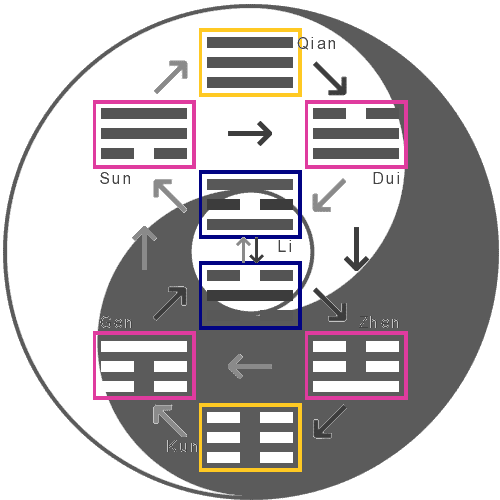We have seen earlier that the hexagrams with which the I Ching responds to us are messages from our unconscious to our daily consciousness. This sounds beautiful at first. In practice, however, it quickly becomes clear how challenging it is: How should one understand the meaning of the I Ching’s response to the question formulated during the consultation? And how can one work with or implement these answers concretely?
The questioner already knows the answer
There is an ancient wisdom that states: The questioner already knows the answer. Reflect on this yourself; it has probably been true in your life as well. Therefore, the crucial point in consulting the I Ching is not so much the answer it provides but the wise question posed to it. An the seeker’s question is to be considered wise because it precisely outlines the core of the matter (or the core of the problem). We have been aware of where the shoe pinches, what is not quite right, and we have poured this knowledge into a wise question and posed to the I Ching.
And perhaps (but only perhaps), at the moment we formulated our wise question, we already sensed in which direction we should move to resolve the situation. In this sense, the concrete answer of the hexagram merely aims to give us a little nudge.
Capturing the Meaning of the Hexagram
Step 1: Formal Approach in Section Dynamics of the Hexagram
This brings us to the interpretation model of no2DO. On the individual hexagram page, in the section The Hexagram’s Inner Trigrams, we start by formally structuring our individual hexagram. This means that we break it down into a sequence of four trigrams (Lower Trigram → First Core Character → Second Core Character → Upper Trigram). The section The Hexagram’s Inner Trigrams in the Context of Yin and Yang graphically illustrates how the trigrams follow each other.
Step 2: Specific Impulses in the Section Changes and Impulses
In the section Changes and Impulses, the focus is on grasping the hexagram’s meaning. What does the hexagram specifically mean for me, for my life, for the situation I find myself in? What is the hexagram trying to convey to me, what answer does it hold for me, and which path does it want to guide me towards?
The key to understanding lies in the transformations/changes, in other words, the transitions from one trigram to the next. In the section Changes and Impulses, specific individual steps are formulated, including suggestions and questions. They invite us to take a closer look at certain areas of our personal lives.
The background of this approach is a theory of meaning, which is explained in more detail in the article A Western Approximation. In summary, it can be said that as human beings, we are invited to develop and harmoniously align two core aspects of our existence:

- Our Self-Relation: This refers to how we treat ourselves or how we behave towards ourselves.
Concrete questions might include: Do I know my needs? Do I fulfill them? Do I trust myself? Am I carrying past burdens? - Our World-Relation: This refers to how we interact with other people.
Concrete questions might include: Can I assess myself? Can I set boundaries? Am I constantly letting others overpower me? Can I clearly articulate my needs to others? Does the behavior of other people determine my actions?
The texts in the Changes and Impulses section focus on specific functional areas of our lives, but they are generally formulated. They become specific when we allow them to open a space for us – a space where we become still and begin to feel and listen within ourselves. The answer to our question – the wise question we formulated at the very beginning based on our knowledge of the specific situation – lies within our own inner being.
One further background consideration
The foundation of the texts in the Changes and Impulses section is the following consideration: What can we truly change? The options are: things, places, people.
Experience – yours, mine, and that of many others – has shown that we can hardly change things, places, situations, or other people, no matter how hard we try. It remains a futile and frustrating endeavor. However, there is one thing we can definitely change, simply because we have full access to it: ourselves. Our ego, our operating instance, with all our attitudes toward the world, our reactions to things, places, situations, other people – in short, our environment.
The texts in the Changes and Impulses section aim to provide guidance on where we can work on our attitude.
Step 3: Sensing and Listening (Quick Guide)
As mentioned earlier, the texts in the section Changes and Impulses are generally formulated. However, if you allow these texts to open up a space for you, a space within yourself, then from this space, from your own inner self the individual answer to your very specific question may emerge.
The following procedure has proven very helpful for me:
- I go to the interpretation page of the respective response hexagram and navigate to the Changes and Impulses section. I read the text in the first box (“Lower trigram…”) aloud, including the yellow-marked question.
- Then I close my eyes and give myself 40 seconds. I let the words and, especially, the question(s) resonate with me. Usually, images come to my mind – I am a visual person; perhaps, for you, it could be words, sounds, or smells. I briefly sketch or note down these images (or words, sounds, smells).
- Next, I move to the next box, repeat the process, read text and questions, close my eyes, wait for something to appear in my mind’s eye, take notes. And repeat the process further until I finally reach the last box (“Upper trigram…”).
- In the end, I read through all my notes. Sometimes, this process leads to a collage, as in the case of Hexagram 57.
With this response – such as my collage from Hexagram 57 – I live for a while. I keep my image where I can see it several times a day. I go about my days, contemplate the answer, apply it, observe the effects of its implementation.
A few closing words
While much positive change can be achieved individually, we are also social beings and experience particularly positive development in trusting interaction with others. This can be with a friend, a group of like-minded individuals, within a support group, or sometimes with a professionally trained coach or therapist. Do not hesitate to make connections. We all carry the burdens of our ancestors within us – war and trauma. It is only right to seek support on our journey.
I wish you all the best!
Karin Soika



